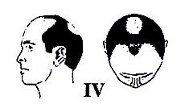Most men will experience at least some degree of genetic hair loss by the time they are in their 50s. Read further to explore the causes, classification, diagnosis, and treatment of hair loss in men.
Causes
The most common cause of hair loss in men is androgenetic alopecia, also referred to as “male pattern” or “common” baldness. It is caused by the effects of the male hormone dihydrotestosterone (DHT) on genetically susceptible scalp hair follicles. DHT causes male hair loss by shortening the growth, or “anagen,” phase of the hair cycle, which results in the follicles producing progressively shorter, finer hairs, a process called miniaturization. With prolonged exposure to DHT, the genetically susceptible follicles eventually disappear leaving a bald scalp. Click here to read an in-depth review of the Causes of Hair Loss In Men.
Classification
The Norwood classification, published in 1975 by Dr. O’tar Norwood, is the most widely used classification for hair loss in men.
It defines two major observable patterns of hair loss and several less common types. In the regular Norwood pattern, two areas of hair loss — a bi-temporal recession and thinning crown — gradually enlarge and coalesce until the entire front, top, and crown (vertex) of the scalp are bald. Click here to visit our page on the Classification of Hair Loss in Men.
Diagnosis
The diagnosis of androgenetic alopecia in men is generally straightforward. It is made by observing a “patterned” distribution of hair loss and confirmed by observing the presence of miniaturized hair in the areas of thinning.
Miniaturization can be observed using a diagnostic instrument called a video densitometer. Click here to read about the Diagnosis of Hair Loss in Men.
Treatment
Men’s hair loss can be effectively treated in two primary ways: hair loss medication and surgical hair restoration. The two most effective medications are the oral medication finasteride (Propecia) and the topical medication minoxidil (Rogaine). Modern surgical hair restoration procedures include Follicular Unit Transplantation (FUT), Follicular Unit Extraction (FUE), and Robotic Hair Transplantation (R-FUE). In these procedures — which Dr. Bernstein pioneered — hair is transplanted from the back or sides of the scalp to the balding areas, where they grow permanent hairs. Click here to read about the Treatment of Hair Loss in Men.
Bernstein Medical is a state-of-the-art hair restoration facility, and we perform only the most modern techniques for patients who visit from around the world. Our facility performs all FUE hair transplants using the groundbreaking technology of the ARTAS® Robotic System.
View before and after photos of over 200 of our patients in our hair transplant photo galleries.
If you have concerns about your hair loss, it is always best to be examined by a board certified hair loss specialist. You can set up an in-person physician consultation. If you cannot visit our NYC facility for an in-person consult, you may submit an online consultation from the comfort of your home.








